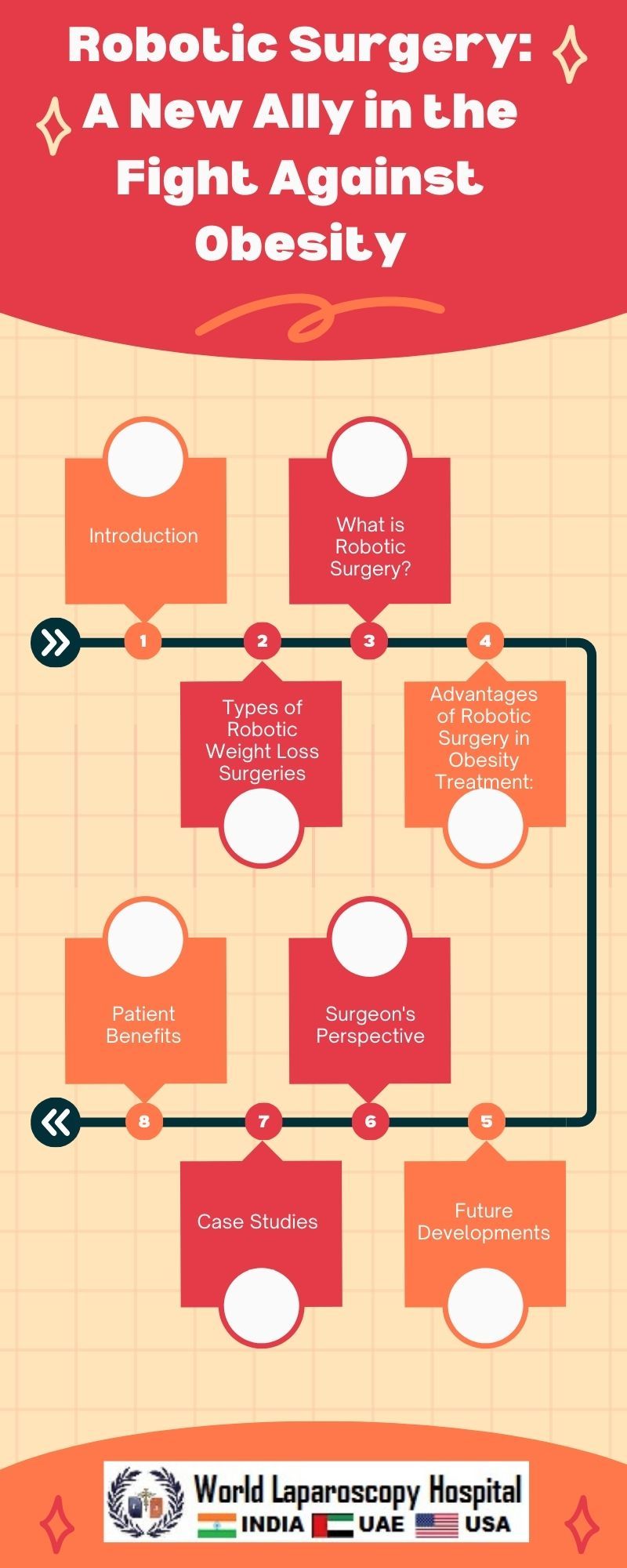Robotic Surgery: A New Ally in the Fight Against Obesity
Introduction:
Obesity has reached alarming proportions worldwide, posing a significant threat to public health. Traditional interventions, such as diet and exercise, often yield short-term results, leaving a substantial number of individuals grappling with the challenges of sustained weight loss. In recent years, the integration of robotic surgery into the field of bariatric medicine has marked a paradigm shift, offering hope and novel possibilities for individuals battling obesity.

The Evolution of Robotic Surgery:
A Brief Overview: Robotic surgery has evolved from its early experimental stages to become a mainstream component of various medical specialties. Initially developed for minimally invasive procedures, robotic-assisted surgery has progressively expanded its applications, with the da Vinci Surgical System leading the way. The da Vinci system, with its robotic arms and advanced imaging capabilities, has proven instrumental in surgeries ranging from cardiac procedures to gynecological interventions. Its precision and dexterity have laid the groundwork for its integration into the complex realm of bariatric surgery.
Current Landscape of Robotic Bariatric Surgery:
The current state of robotic bariatric surgery is characterized by a range of procedures designed to address obesity effectively. From Roux-en-Y gastric bypass to sleeve gastrectomy, robotic-assisted techniques provide surgeons with enhanced vision, improved control, and increased maneuverability within the confined spaces of the human body. These advantages translate into reduced complications, quicker recovery times, and improved outcomes for patients.
Advantages of Robotic Surgery in Bariatrics:
Precision and Accuracy:
Robotic systems offer unparalleled precision, allowing surgeons to navigate delicate anatomical structures with enhanced accuracy. This precision reduces the risk of complications, such as bleeding and injury to surrounding tissues, leading to improved patient safety.
Minimally Invasive Nature:
Traditional bariatric surgeries often involve large incisions, leading to extended recovery times and increased postoperative pain. Robotic bariatric procedures, on the other hand, leverage smaller incisions, resulting in less trauma to the body, reduced scarring, and faster recovery for patients.
Enhanced Visualization:
The advanced imaging systems integrated into robotic platforms provide surgeons with high-definition, three-dimensional views of the operative field. This improved visualization allows for better decision-making during surgery and contributes to the overall success of the procedure.
Greater Maneuverability:
The robotic arms used in surgery mimic the natural movements of the human hand but with increased dexterity. Surgeons can navigate tight spaces and perform intricate tasks with greater ease, facilitating complex bariatric procedures that might be challenging with traditional methods.
Success Stories and Patient Outcomes:
Numerous success stories have emerged from the intersection of robotic surgery and bariatrics. Patients undergoing robotic-assisted weight loss procedures report shorter hospital stays, reduced postoperative pain, and faster return to normal activities. Long-term weight loss outcomes are encouraging, with many individuals achieving and maintaining significant weight reduction, leading to improvements in obesity-related comorbidities.
Challenges and Limitations:
While robotic surgery holds immense promise in the battle against obesity, it is crucial to acknowledge the existing challenges and limitations. These include the high cost of robotic systems, the need for specialized training for surgeons, and limited access to this technology in certain regions. Addressing these barriers is essential to ensure equitable access to the benefits of robotic bariatric surgery.
Future Prospects and Innovations:
As technology continues to advance, the future of robotic bariatric surgery appears promising. Ongoing research explores the integration of artificial intelligence (AI) and machine learning algorithms to further enhance surgical precision and personalize treatment plans. Additionally, the development of more affordable robotic platforms aims to broaden access to this transformative technology, extending its impact on global obesity rates.
Ethical Considerations:
The adoption of robotic surgery in bariatrics raises ethical considerations, including the potential for medicalization of weight loss and the role of technology in shaping societal perceptions of body image. As these technologies become more prevalent, it is crucial to engage in ethical discourse to ensure responsible and equitable use in the context of obesity management.
Conclusion:
Robotic surgery has emerged as a revolutionary ally in the ongoing battle against obesity. Its precision, minimally invasive nature, and enhanced visualization contribute to improved patient outcomes and offer a ray of hope for those struggling with excess weight. While challenges and ethical considerations remain, ongoing advancements and research promise to further refine and expand the role of robotic bariatric surgery, heralding a new era in the comprehensive and effective management of obesity. As the field continues to evolve, the synergy between technology and medicine holds the potential to transform countless lives, making significant strides in the global fight against obesity.


